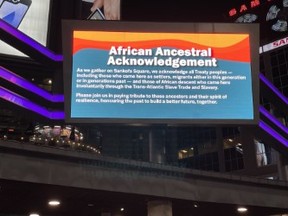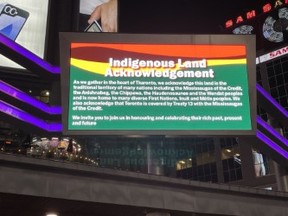
Article content
Without even being voted on by city councillors, or Torontonians, the city’s main urban square now has not just one land acknowledgement — but two.
Advertisement 2
Article content
Like it or not, the “Indigenous land acknowledgement” which refers to Toronto as “Tkaronto” has been around for a while.
But one called the “African Ancestral Acknowledgment” is something new at Yonge-Dundas Square, which is now being referred to as Sankofa Square — despite the name change not becoming official until 2025.
Sankofa Square is already written on the signage and appears in the square’s neon video displays.

Toronto’s history is not only being erased right before our eyes, but it’s also being rewritten. And that’s not happening because taxpayers voted for it.
Voters and elected officials have no backbone and are allowing cultural revolutionaries to cancel our historical figures and replace them with what they think is more politically correct and appropriate.
Advertisement 3
Article content
Article content
Advertisement 4
Article content
“As we gather on Sankofa Square, we acknowledge all treaty peoples – including those who came here as settlers, migrants either in this generation or in generations past – and those of African descent who came here involuntarily through the Trans-Atlantic Slave Trade and Slavery. Please join us in paying tribute to those ancestors and their spirit of resilience, honouring the past to build a better future together.”
That’s what it’s on the digital signs.
But if you look at Government of Canada history posted on the web, Toronto is not mentioned as a hotbed of any slavery between 1629 and 1834.
Advertisement 5
Article content
So, why is this acknowledgement — stemming from something that began almost 400 years ago and ended almost 200 years ago, and has no significant history in Toronto — up in the city’s main tourism area?
Recommended video
It’s hard to get calls back from elected officials.
Mayor Olivia Chow or Councillor Chris Moise, who represents the square area, have yet to respond. But we did hear from city spokesperson Russell Baker, manager, media relations and issues management:
This new land acknowledgement is on display. Was it voted on by council or decided on by the local councillor and city staff?
“The African Ancestral Acknowledgement, now on display at Sankofa Square, was introduced by the City of Toronto’s Confronting Anti-Black Racism (CABR) Unit in May 2018. This acknowledgment was not specifically voted on by Council, but is a voluntary recognition offered to support Black staff. Sankofa Square, as an agency of the City, adopted the acknowledgement with minor adjustments to adapt it for the digital screen medium and to engage passersby. The display version was developed in consultation with city staff from the CABR Unit and the Indigenous Affairs Office.”
Advertisement 6
Article content
Q: Where did the information in the acknowledgement come from? What is the source of the research?
“The African Ancestral Acknowledgment is rooted in extensive consultations with African and Indigenous elders, leaders, and community members, along with staff and leadership from the City of Toronto. The acknowledgement was developed in collaboration with the CABR Unit and the Indigenous Affairs Office, reflecting insights and guidance from these groups. The city recognizes the historical presence and contributions of African ancestors on these lands and is committed to confronting systemic barriers faced by Toronto’s Black communities.”
Q: When is the name change to Sankofa happening? The name is now on display there.
Advertisement 7
Article content
“The name has officially been changed to “Sankofa Square,” as adopted by Toronto City Council on December 13, 2023, with a by-law amendment on June 27, 2024. While the name is now in use, the rebranding process is ongoing and involves transitioning digital assets, documentation, physical signage, community outreach and developing the overall brand identity. During this period, it is common for old and new identities to coexist. The complete transformation, including physical and digital rebranding, is expected to be finalized by early 2025. For more details, please refer to the City of Toronto’s website.”
Advertisement 8
Article content
The square’s website explains “Sankofa (SAHN-koh-fah) is a Twi word from the Akan Tribe of Ghana that loosely translates to, ‘go back and get it.’ Its literal translation comes from the Akan proverb, “Se wo were fi na wosan kofa a yenkyiri,” meaning, “It is not taboo to go back for what you forgot (or left behind).” Sankofa is a phrase that encourages learning from the past to inform the future. While Sankofa originates from the Ghanaian Akan language, it broadly resonates across African and Black communities globally as an expression of cultural and political affirmation.”

So while the city’s history has nothing to do with Ghana or its customs and was not a hub of slavery, its most visible urban landmark will be named and acknowledged as if it was. While the city hasn’t been able to do anything about the opioid overdoses right in the square, the break-ins, carjackings, sexual assaults, robberies, stabbings and shootings, they have managed to re-brand the square into something with no connection to Toronto.
Without Toronto citizens voting for it.
Recommended from Editorial
Article content







